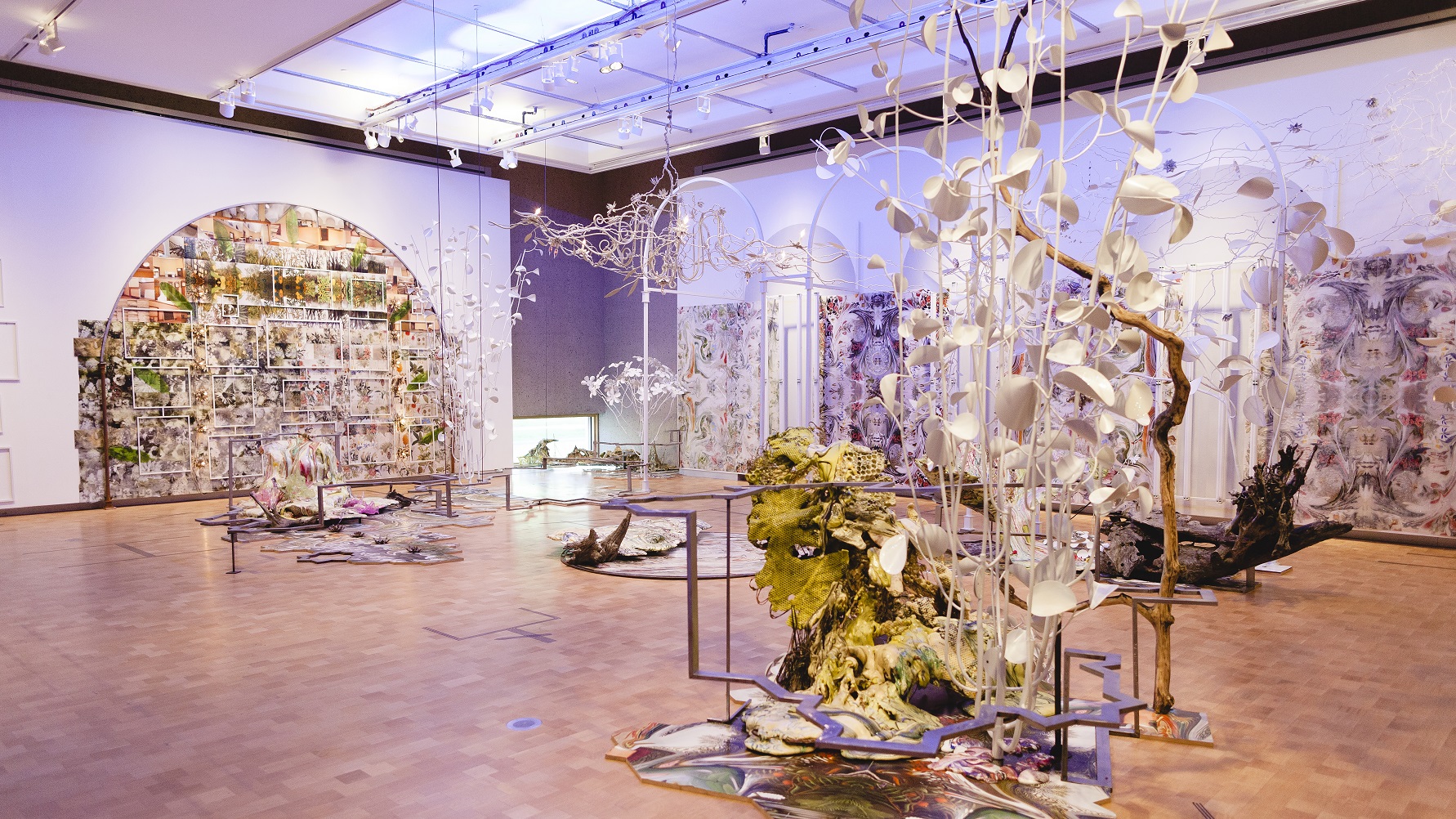The Disruptive Roots of African Art Studies in America

The Barnes Foundation’s current exhibition, Mark Dion, Judy Pfaff, Fred Wilson: The Order of Things, epitomizes the business buzz phrase “disruptive innovation” like few other museum shows (which I wrote about here). Disrupt or die, the thinking goes. Old orders must make way for new. Coincidentally, as the Barnes Foundation, home of Dr. Albert Barnes’ meticulously and idiosyncratically ordered collection of Impressionist and Post-Impressionist masterpieces left just so since his death in 1951, invites outsider artists to question and challenge Dr. Barnes’ old order, it also publishes their own insider’s critical “warts and all” assessment of Dr. Barnes’ relationship to African art and African-Americans. In African Art in the Barnes Foundation: The Triumph of L’Art nègre and the Harlem Renaissance, scholar Christa Clarke reassesses Dr. Barnes intentions and results in his building of the first great African art collection in America. “More than just formal accents to modernist paintings and other Western art in the collection,” Clarke argues, “African art deserves to be seen as central to the aesthetic mission and progressive vision that was at the very heart of the Barnes Foundation.”
Dr. Barnes aggressively purchased his African art collection between 1922 and 1924 mainly from the Parisian dealer Paul Guillaume. When the original Barnes Foundation home opened in 1925 in Merion, Pennsylvania, architect Paul Cret incorporated parts of the African art collection in the design of the exterior. African art literally greeted visitors at the doorstep, thus testifying to the central role of African art in the Barnes Foundation’s purpose. By the time Dr. Barnes began collecting African art, the connection between “primitive” African art and modern art was well established. Paris galleries had already paired Picassos and others with African art, so Dr. Barnes’ pairings weren’t necessarily new. What was new, however, was the social engineering behind the ensembles.
Unlike the catalog for The Order of Things exhibition, Clarke cites John Dewey (as well as George Santayana and William James) as influences on Dr. Barnes’ intentions for the Barnes Foundation and the African art collection it contained. Working from the ruthlessly formalist concept of “plastic form,” Dr. Barnes created an (ostensibly) apolitical, culturally neutral aesthetic against which to measure all art, with African art surprisingly and encouragingly emerging as “the purest expression of three-dimensional form and therefore one of the world’s great art traditions,” as Clarke explains. Such ideas were music to the ears of the Harlem Renaissance artists and exponents hoping for a cultural foundation upon which to build their own modern art movement as a way of finding a place (and, they hoped, equality) in American culture and society. The African-American thinker Alain Locke, whose 1925 anthology The New Negrobecame the Harlem Renaissance’s “Declaration of Independence,” embraced Dr. Barnes as a kindred spirit, going so far as to invite Dr. Barnes to contribute to that founding work.
But, as African Art in the Barnes Foundation honestly admits, that embrace of Dr. Barnes by the African-American community wasn’t always wholehearted. As Clarke writes, “Though Locke apparently found certain aspects of Barnes’s essay patronizing, he nonetheless chose to include it in the book.” Tucked away in an endnote, however, Clarke more bluntly continues: “Barnes’s praises of ‘negro character’ were often laced with racist stereotypes typical for whites of the era. Locke may have taken issue with Barnes’s assessment of the fundamental emotional quality of ‘Negro’ art.” From a modern perspective, Dr. Barnes’ period-prevalent prejudices are forgivable when weighed against his overwhelmingly good intentions for African-Americans. What troublingly lingers, however, is Dr. Barnes’ unintentional malpractice in terms of not only collecting African art, but presenting that collection as representative of African art.
As Clarke thoroughly explains, Dr. Barnes’ quick study of African art led him to draw conclusions and form his characteristic strong-willed conclusions about the field. Clarke uses the Barnes Foundation’s initial publication cataloging the collection and serving as a textbook of sorts for study — Primitive Negro Sculpture— as the source of many of these errors of exclusion. When it came time to categorize regional traditions, Clarke asserts, “[t]he selection was based entirely on Barnes’s collection, an inherently restrictive method that highlighted certain genres of art from within those regions favored by Barnes, to the automatic exclusion of many others.” Since the French Guillaume served as the source of much of the collection, understandably much of the art came from French colonies in Africa, thus excluding much of Eastern and Southern Africa. To supply the demand of the growing market for collectors, many pieces were often taken by force from natives who used the objects for social or religious functions. Perhaps worse, many objects were made to order and even distressed to look older and, therefore, more authentic. (Dr. Barnes believed many objects in his African collection to be much older than they really were.) Conversely, many objects were cleaned up or had pieces removed to strip them down to the more austere, sculptural look (such as the Dan peoples mask shown above, left) favored by Dr. Barnes and other collectors drawn to African art by modern European art’s borrowings. Barnes’ preference for figurative art (such as the Dogon peoples paired figures shown above, right) also skewed the collection in an unrepresentative way.
Clarke admits at the end of her essay that “[t]here is some irony in the fact that Barnes’s original focus on the visual elements of African sculpture, free of wall labels and text panels, may have hindered a full appreciation of the cultural and social complexities of the works in his collection.” Snapping off a tiny figural sculpture from the top of a ceremonial walking stick or ripping away the loincloth from another figure to reveal anatomically correct elements beneath seem like gross violations today, but, just like Dr. Barnes’ turn-of-the-20th-century soft racism alluded to above, they can be forgiven if acknowledged and corrected. Dr. Barnes truly believed that removing African art from its context would allow for a non-prejudiced assessment of its merits, but never saw that it could be a different type of blindness. It may have taken more than half a century after Dr. Barnes’ death in 1951, but the Barnes Foundation may finally feel free enough at last to admit his errors in order to sing his praises clearly and accurately.
If #blacklivesmatterreally matters, we should weigh both the good and bad of Dr. Barnes’ achievement in African art seriously. African Art in the Barnes Foundation: The Triumph of L’Art nègre and the Harlem Renaissancerecounts the troubled roots of Dr. Barnes’ attempt to get African art seen as more than just an archaeologic curiosity and a true aesthetic heritage. Now the job is to rewrite the terms of that aesthetic heritage from Dr. Barnes’ own (well-intentioned) biases to a more accurate portrait that recognizes how these African lives mattered and still matter to African-Americans struggling to find their identity in a country still divided by matters of race. If Dr. Barnes’ beginnings can end in a “disruptive innovation” that engages more people in a productive dialogue on race, then his “back to Africa” movement of sorts might inspire a movement back to American founding principles of equality and freedom.
[Image: (left) Face Mask, late 19th–early 20th century. Dan peoples, Côte d’Ivoire. Wood, 9 5/8 x 5 1/8 x 2 5/8 in. (24.4 x 13 x 6.7 cm). A110. Photo: © 2012 The Barnes Foundation. (right) Seated Couple, late 19th–early 20th century. Dogon peoples, Mali. Wood, 25 3/8 x 9 3/4 x 9 1/8 in. (64.5 x 24.8 x 23.2 cm). A197. Photo: © 2012 The Barnes Foundation.]
[Many thanks to the Barnes Foundation for the images above. Many thanks also to Rizzoli for providing me with a review copy of African Art in the Barnes Foundation: The Triumph of L’Art nègre and the Harlem Renaissance, by Christa Clarke, with contributions by Arthur Bourgeois, Nichole Bridges, Kevin Dumouchelle, and Kate Ezra.]
[Please follow me on Twitter (@BobDPictureThis) and Facebook (Art Blog By Bob) for more art news and views.]





